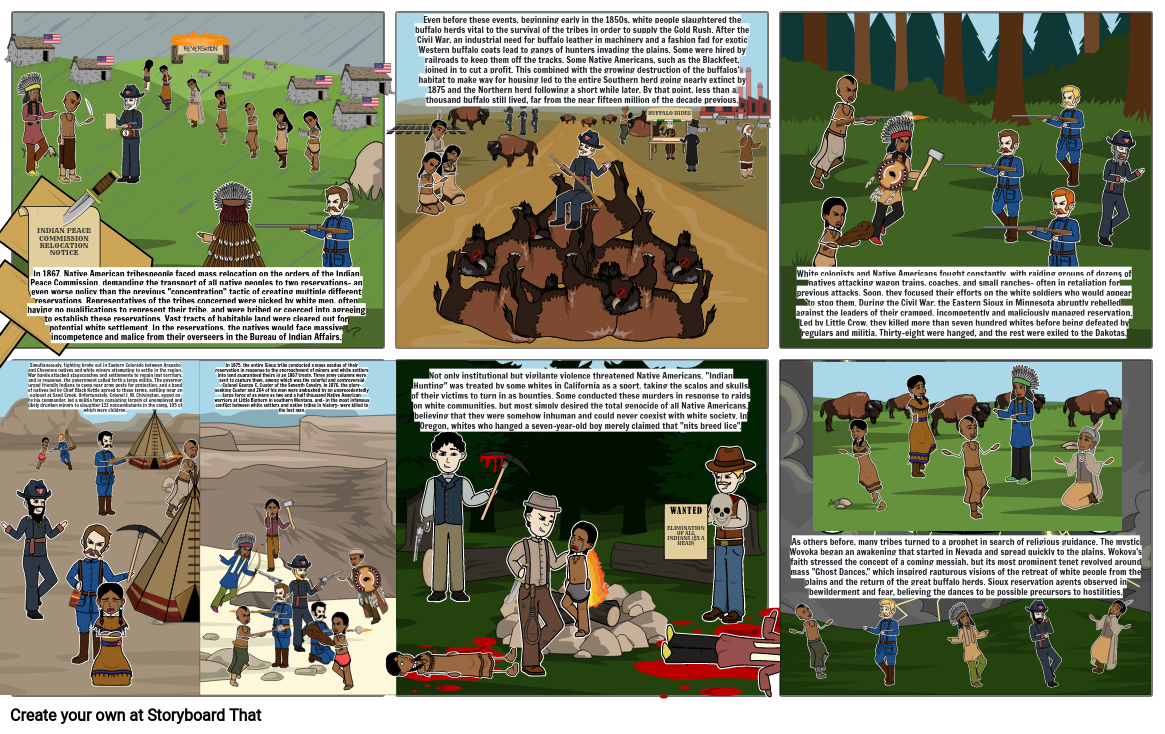Dispersal of the Tribes

Texto del Guión Gráfico
- INDIAN PEACE COMMISSION RELOCATION NOTICE
- In 1867, Native American tribespeople faced mass relocation on the orders of the Indian Peace Commission, demanding the transport of all native peoples to two reservations- an even worse policy than the previous "concentration" tactic of creating multiple different reservations. Representatives of the tribes concerned were picked by white men, often having no qualifications to represent their tribe, and were bribed or coerced into agreeing to establish these reservations. Vast tracts of habitable land were cleared out for potential white settlement. In the reservations, the natives would face massive incompetence and malice from their overseers in the Bureau of Indian Affairs.
- Simultaneously, fighting broke out in Eastern Colorado between Arapaho and Cheyenne natives and white miners attempting to settle in the region. War bands attacked stagecoaches and settlements to regain lost territory, and in response, the government called forth a large militia. The governor urged friendly Indians to camp near army posts for protection, and a band of natives led by Chief Black Kettle agreed to these terms, settling near an outpost at Sand Creek. Unfortunately, Colonel J. M. Chivington, egged on by his commander, led a militia force consisting largely of unemployed and likely drunken miners to slaughter 133 noncombatants in the camp, 105 of which were children.
-
- REVERSATION
- In 1875, the entire Sioux tribe conducted a mass exodus of their reservation in response to the encroachment of miners and white settlers into land guaranteed theirs in an 1867 treaty. Three army columns were sent to capture them, among which was the colorful and controversial Colonel George C. Custer of the Seventh Cavalry. In 1876, the glory-seeking Custer and 264 of his men were ambushed by an unprecedentedly large force of as many as two and a half thousand Native American warriors at Little Bighorn in southern Montana, and- in the most infamous conflict between white settlers and native tribes in history- were killed to the last man.
- Even before these events, beginning early in the 1850s, white people slaughtered the buffalo herds vital to the survival of the tribes in order to supply the Gold Rush. After the Civil War, an industrial need for buffalo leather in machinery and a fashion fad for exotic Western buffalo coats lead to gangs of hunters invading the plains. Some were hired by railroads to keep them off the tracks. Some Native Americans, such as the Blackfeet, joined in to cut a profit. This combined with the growing destruction of the buffalos' habitat to make way for housing led to the entire Southern herd going nearly extinct by 1875 and the Northern herd following a short while later. By that point, less than a thousand buffalo still lived, far from the near fifteen million of the decade previous.
- BUFFALO HIDES
- White colonists and Native Americans fought constantly, with raiding groups of dozens of natives attacking wagon trains, coaches, and small ranches- often in retaliation for previous attacks. Soon, they focused their efforts on the white soldiers who would appear to stop them. During the Civil War, the Eastern Sioux in Minnesota abruptly rebelled against the leaders of their cramped, incompetently and maliciously managed reservation. Led by Little Crow, they killed more than seven hundred whites before being defeated by regulars and militia. Thirty-eight were hanged, and the rest were exiled to the Dakotas.
- Not only institutional but vigilante violence threatened Native Americans. "Indian Hunting" was treated by some whites in California as a sport, taking the scalps and skulls of their victims to turn in as bounties. Some conducted these murders in response to raids on white communities, but most simply desired the total genocide of all Native Americans, believing that they were somehow inhuman and could never coexist with white society. In Oregon, whites who hanged a seven-year-old boy merely claimed that "nits breed lice".
- ELIMINATION OF ALL INDIANS ($5 A HEAD)
- As others before, many tribes turned to a prophet in search of religious guidance. The mystic Wovoka began an awakening that started in Nevada and spread quickly to the plains. Wokova's faith stressed the concept of a coming messiah, but its most prominent tenet revolved around mass "Ghost Dances," which inspired rapturous visions of the retreat of white people from the plains and the return of the great buffalo herds. Sioux reservation agents observed in bewilderment and fear, believing the dances to be possible precursors to hostilities.
-
Más de 30 millones de guiones gráficos creados
¡Sin Descargas, sin Tarjeta de Crédito y sin Necesidad de Iniciar Sesión Para Probar!


